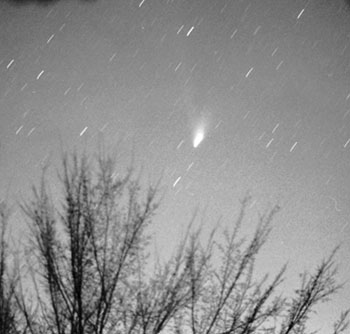 This picture of Hale-Bopp was taken by Jay Thompson, PHS science teacher.
This picture of Hale-Bopp was taken by Jay Thompson, PHS science teacher. This picture of Hale-Bopp was taken by Jay Thompson, PHS science teacher.
This picture of Hale-Bopp was taken by Jay Thompson, PHS science teacher.A comet first discovered in 1995 is lighting up the skies daily over planet Earth. Comet Hale-Bopp is 250 times brighter than Halleyís Comet and is the farthest comet ever discovered by amateurs. Discovering the comet were Alan Hale of Cloudcroft, N.M., and Thoma Bopp, Glendale, Ariz.
Comet Hale-Bopp may only come within 173.5 million miles of Earth but with each pass, appears to become more visible. Many Paynesville area residents have been watching the comet as it passes over our area between 4 and 6 a.m.
Various reports indicate the comet can be seen in the morning sky through March. After March 9, Comet Hale-Bopp became more impressive in the morning skies, as the tail was expected to be extensive by then according to reports. After March 15, it will also be visible in the evening sky.
It will be making its closest approach to Earth about March 22. By March 25, the comet will be at its most northern point in its path. The best viewing in the evening sky with the naked eye is from March 26 to April 10.
What is a comet? According to WCCO meteorologist Mike Lynch, it looks like a dirty snowball. It is a mixture of water, ice, carbon-dioxide ice, dry ice and other imbedded materials. Like planets, comets orbit the sun. When theyíre far away from the sun, comets are relatively inactive. ďBut when these comets get closer to the sun, they begin to melt off and that fuzziness you see is actually called the coma cloud. It is the melted vapor and some of the material getting loose.
Lynch states that right now if itís dark enough in the morning, you can see it very easily. He explains that all you need to do is look straight east and a little bit to the north. Then look up 10 to 20 degrees above the horizon and people can easily spot it. To the naked eye, the comet looks like a fuzzy star, but with binoculars, you can see a tail with it.
Comet Hale-Bopp timeline
ē March 6-21ĖBest times for viewing in the morning sky
ē March15ĖSpectacular to the naked eye in the evening sky
ē March 22ĖClosest approach to the Earth
ē March 26ĖApril 10-Best times for viewing in the evening sky with the naked eye
ē April 10ĖNear highest point above horizon in the evening sky
ē April 25ĖMay 10-Last good views from most of the northern hemisphere
ē May 6ĖComet Hale-Bopp crosses plane of Earthís orbit from north to south
ē May 20-31ĖLast sightings from mid-northern latitudes